Sir John Monash, Personal Files Book 15, 10 May - 9 June 1917, Part 6
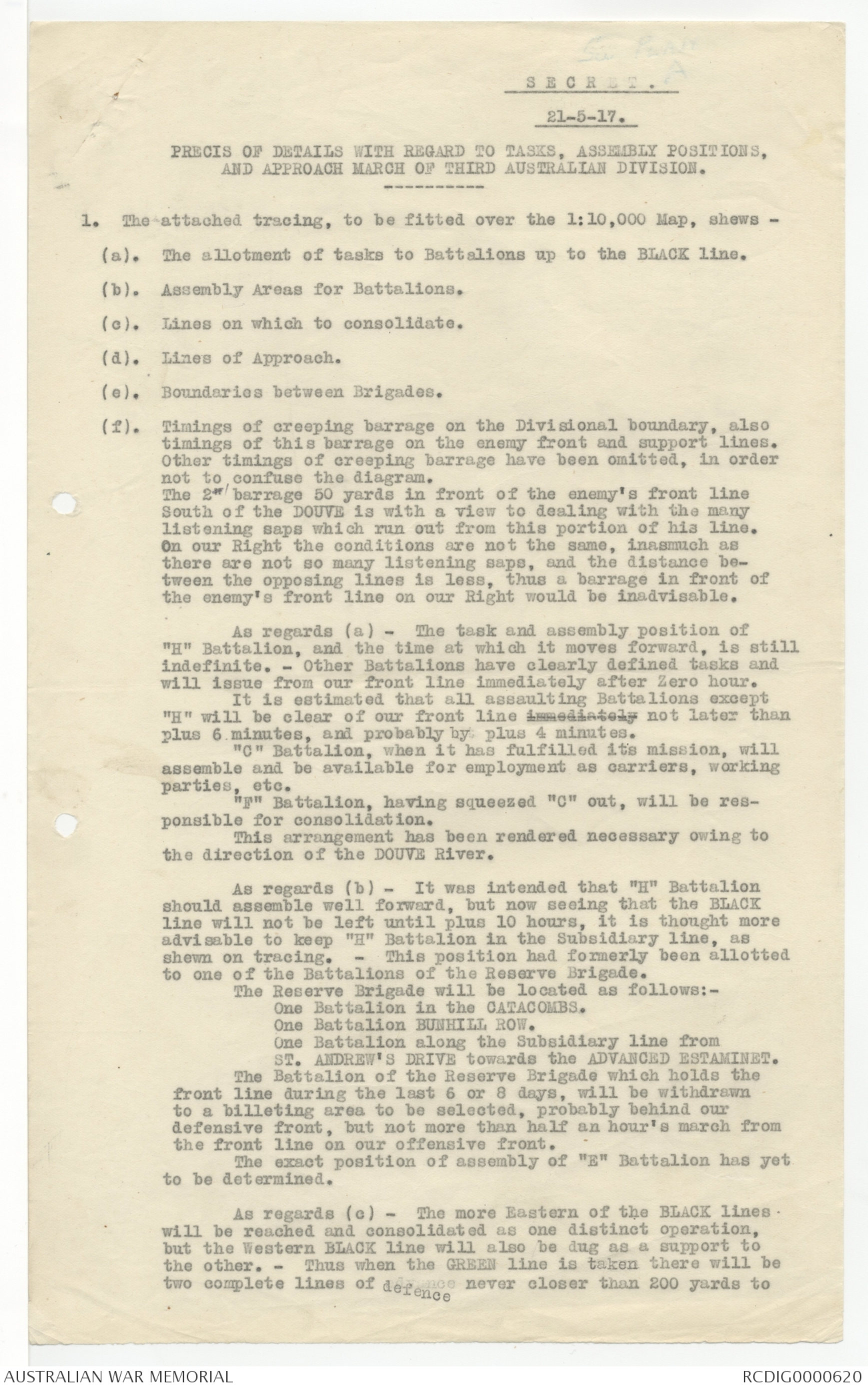
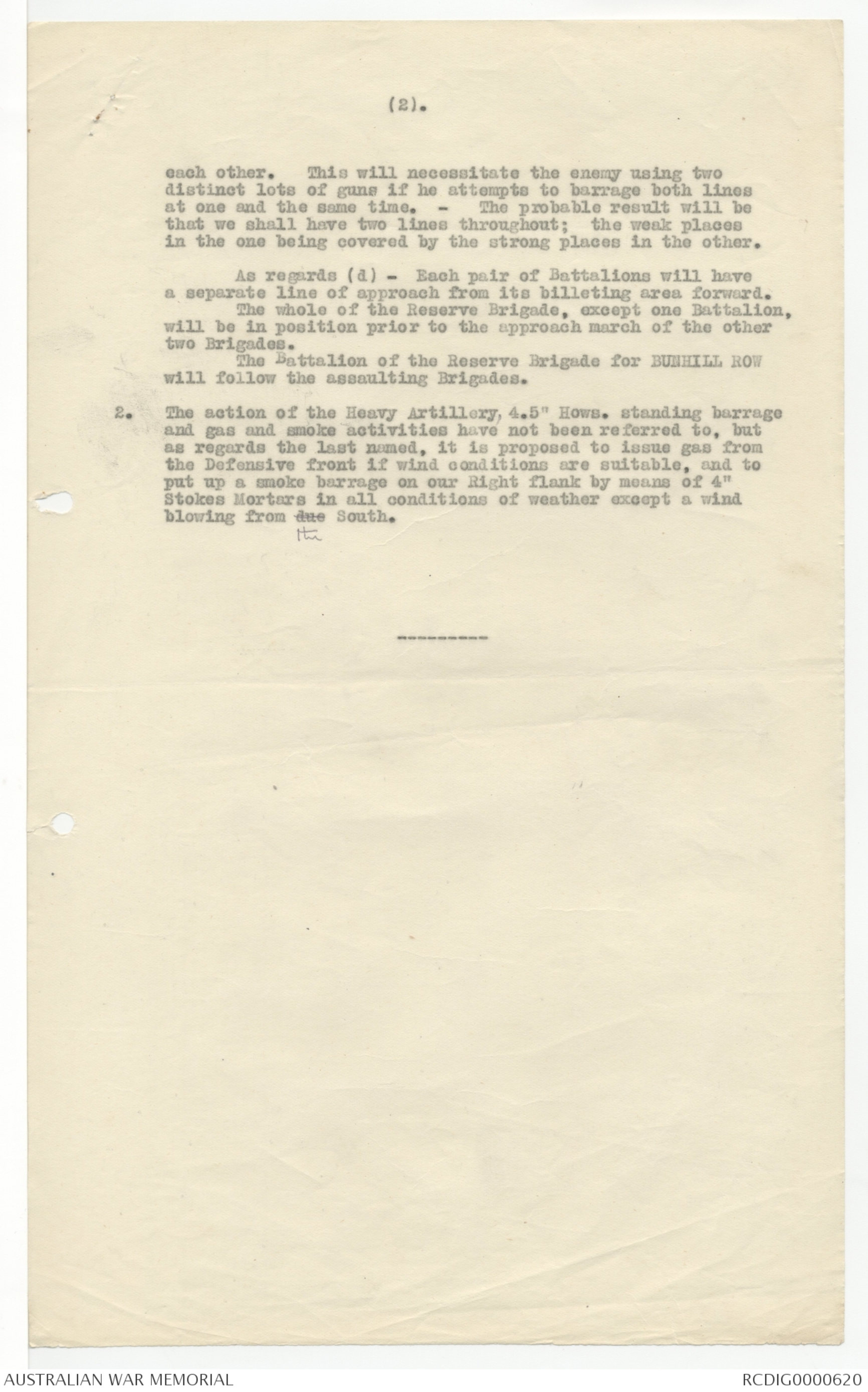
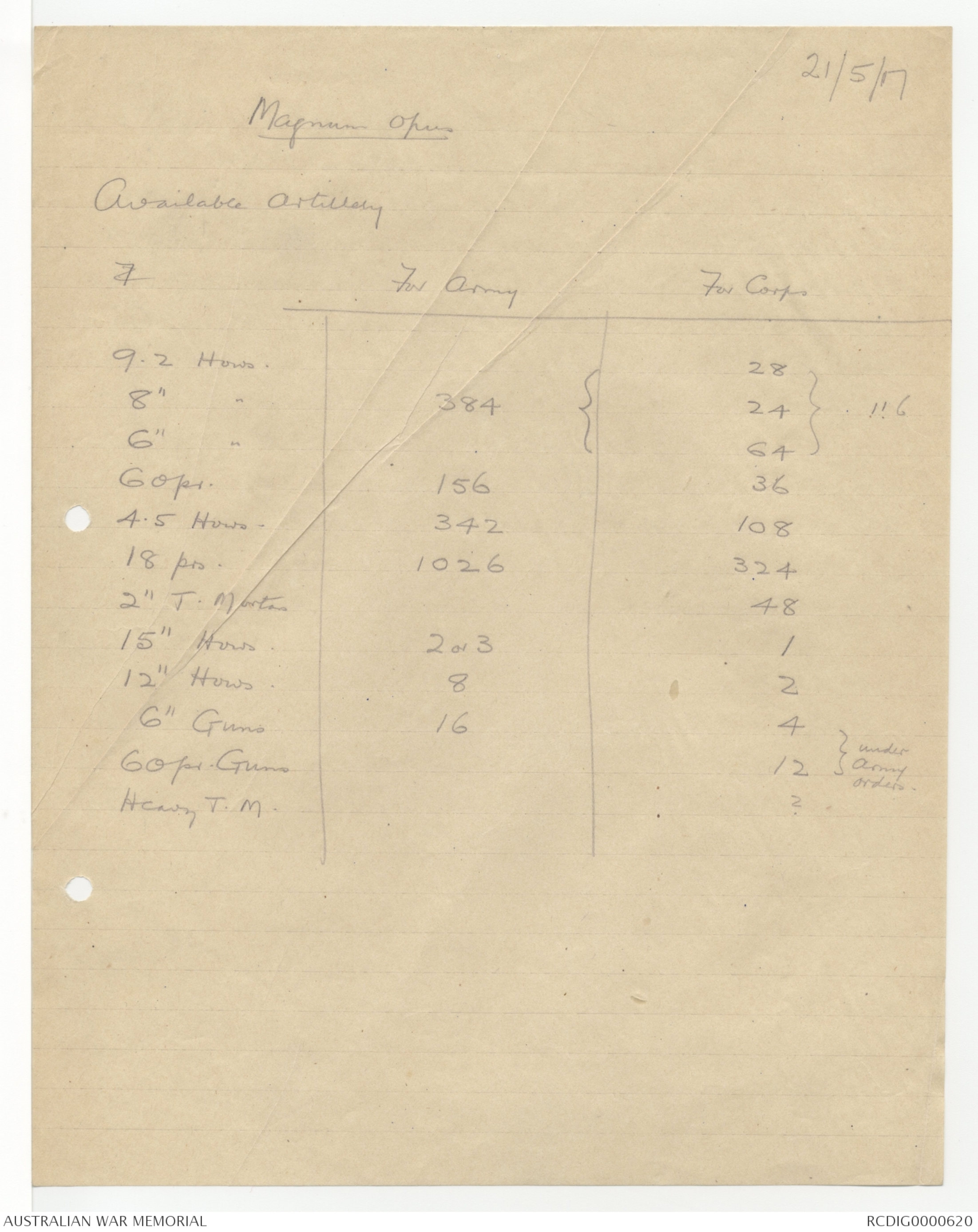
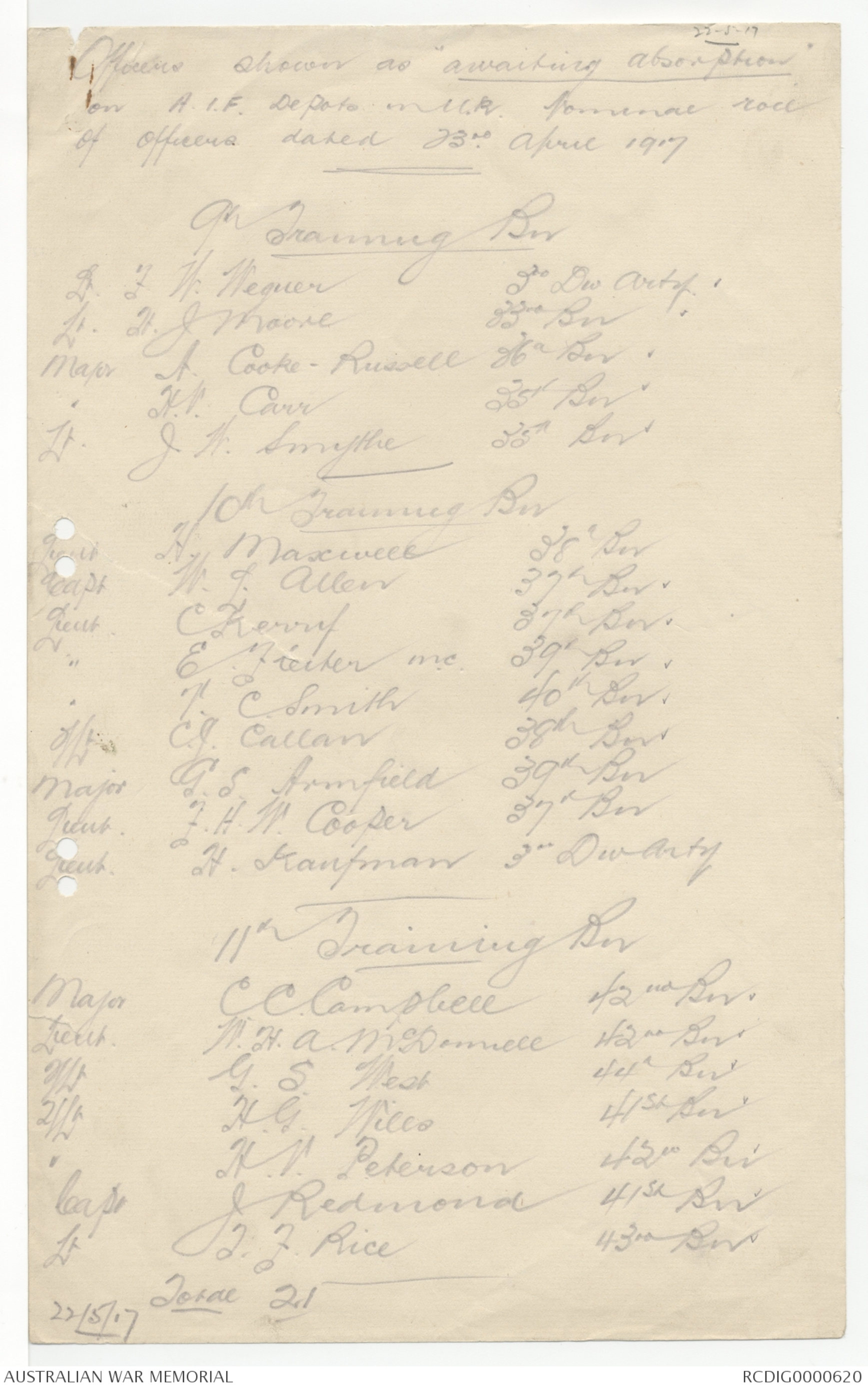
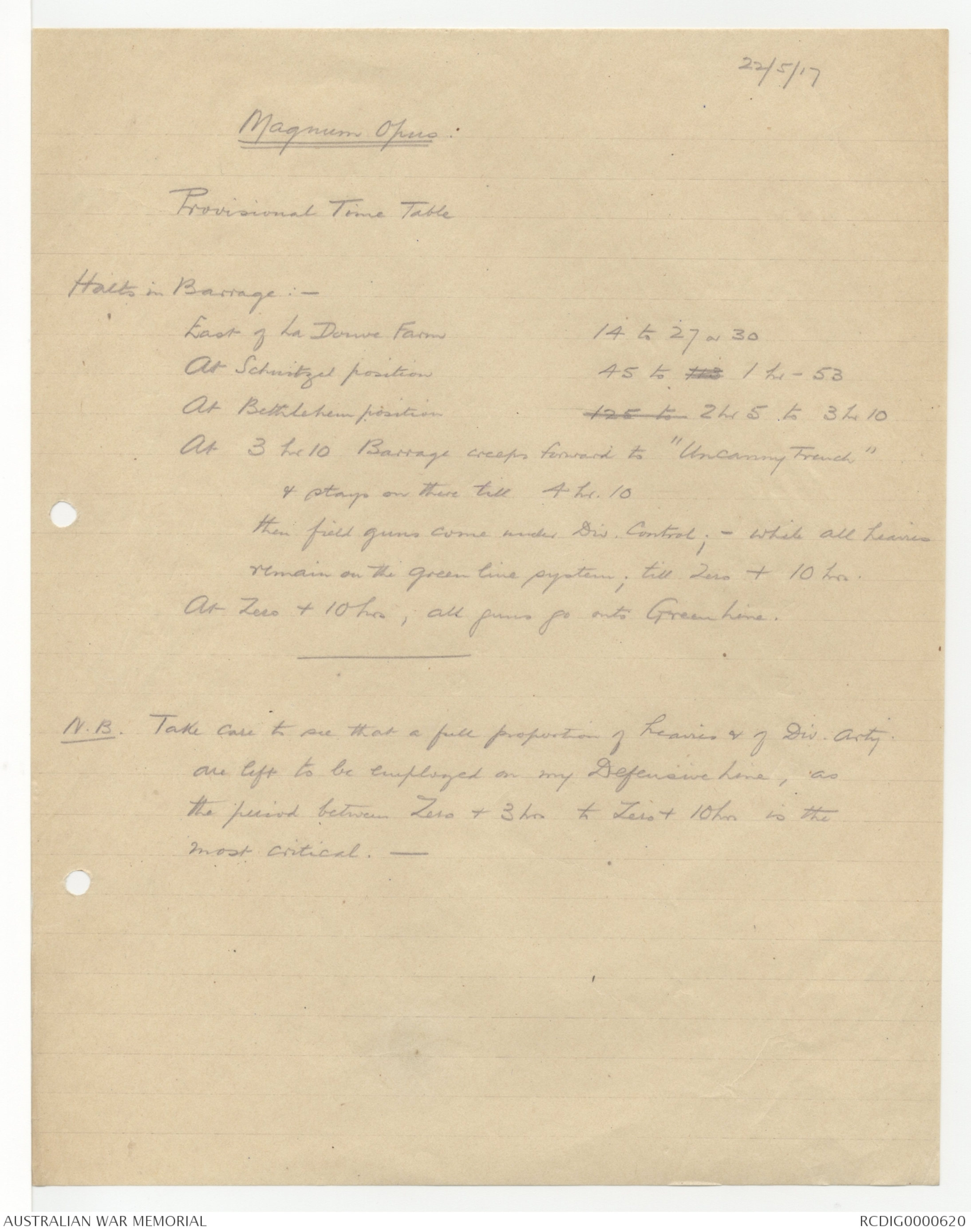
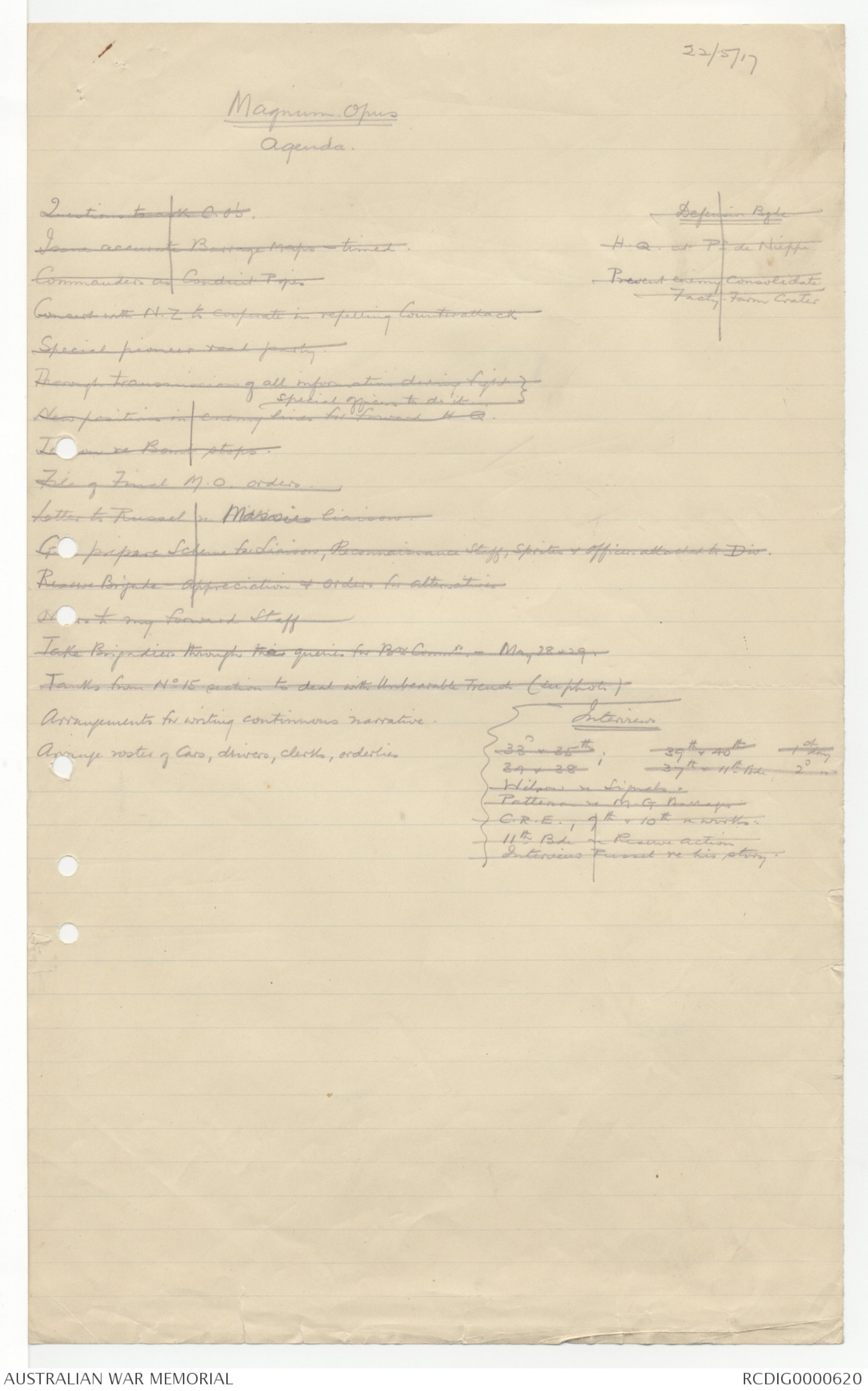
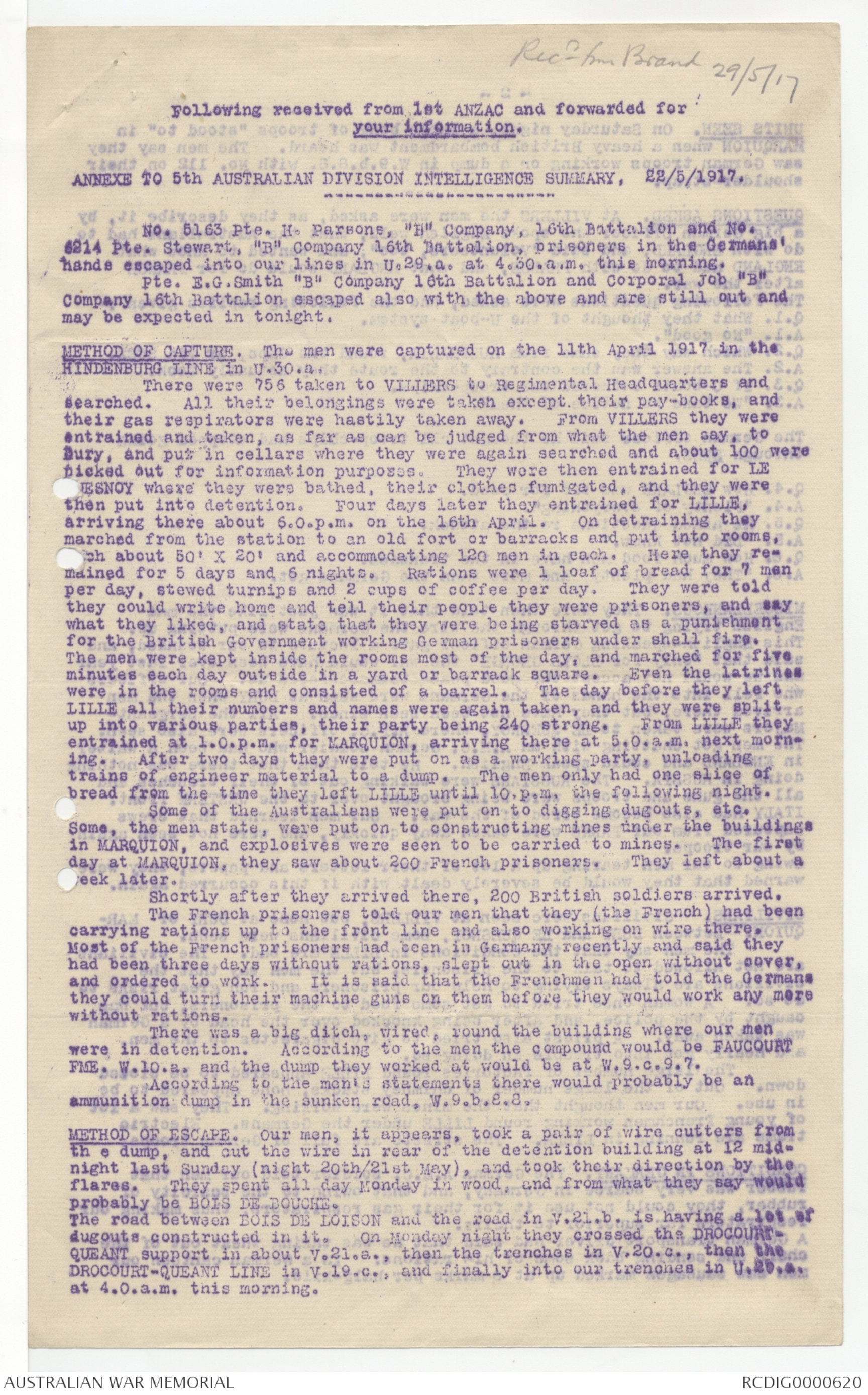
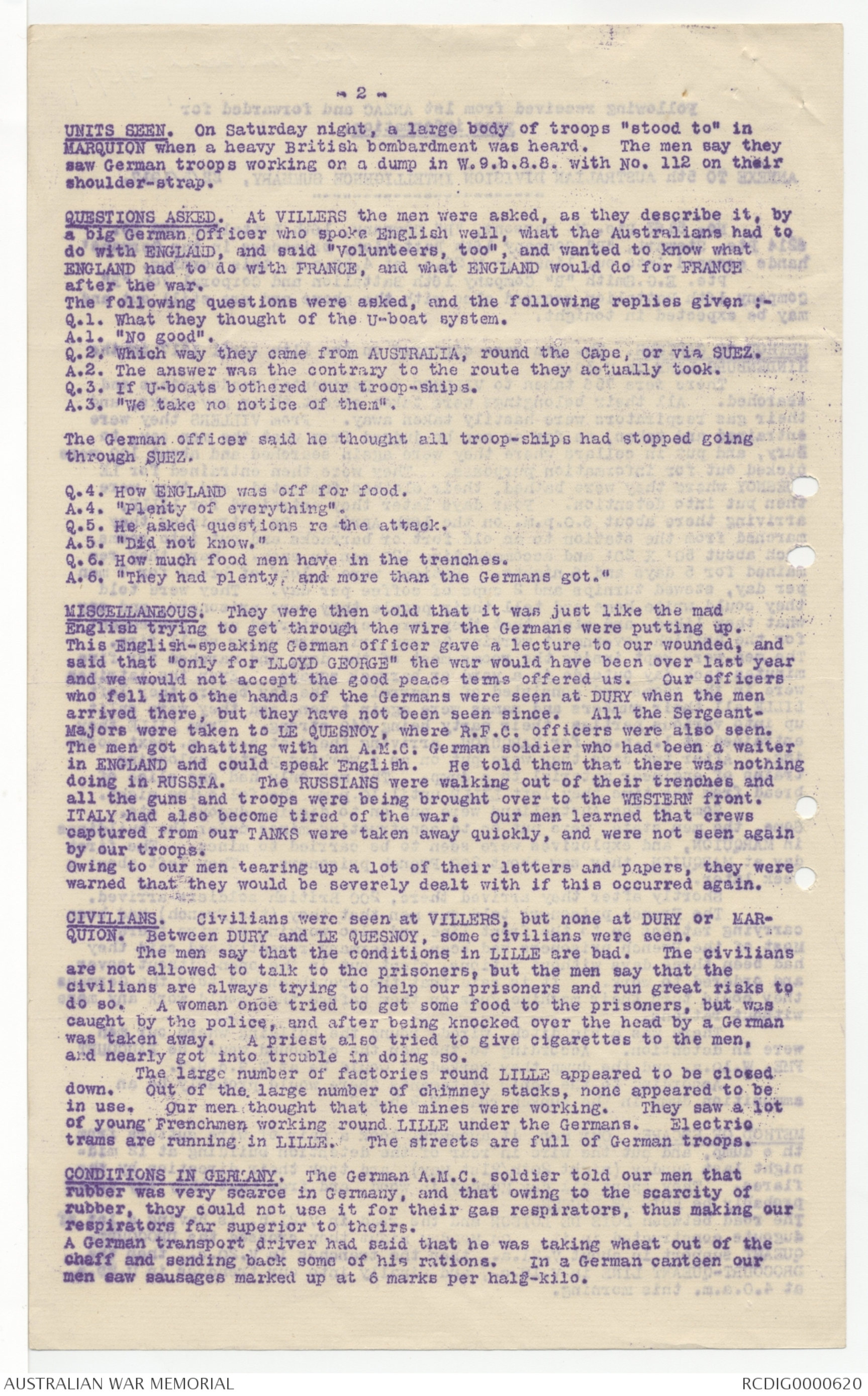
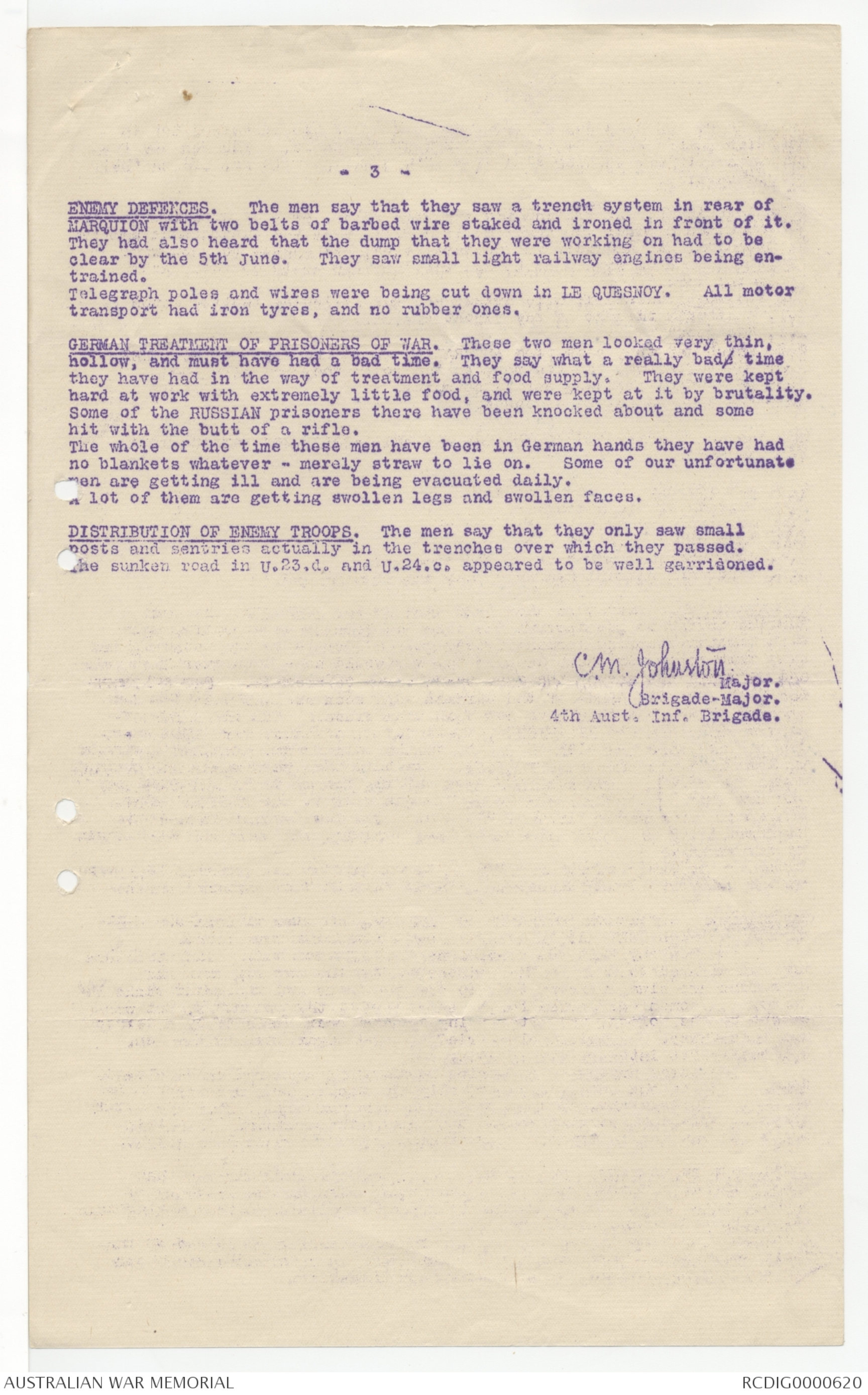
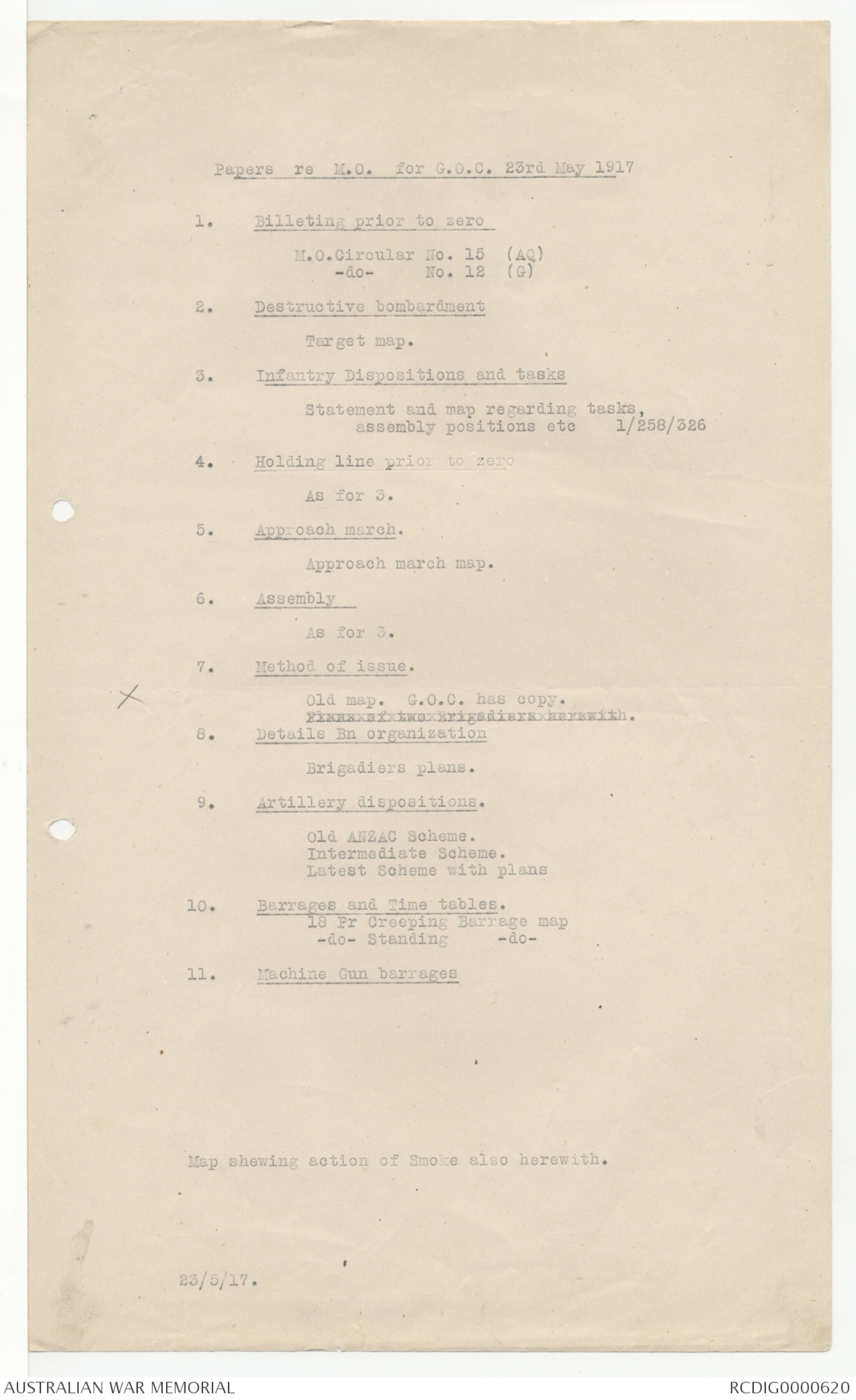
[*See Point
A*]
SECRET.
21-5-17.
PRECIS OF DETAILS WITH REGARD TO TASKS, ASSEMBLY POSITIONS,
AND APPROACH MARCH OF THIRD AUSTRALIAN DIVISION.
1. The attached tracing, to be fitted over the 1:10,000 Map, shews -
(a). The allotment of tasks to Battalions up to BLACK line.
(b). Assembly Areas for Battalions.
(c). Lines on which to consolidate.
(d). Lines of Approach.
(e). Boundaries between Brigades.
(f) Timings of creeping barrage on the Divisional boundary, also
timings of this barrage on the enemy front and support lines.
Other timings of creeping barrage have been omitted, in order
not to confuse the diagram.
The 2nd Barrage 50 yards in front of the enemy's front line
South of the DOUVE is with a view to dealing with the many
listening saps which run out from this portion of his line.
On our Right the conditions are not the same, inasmuch as
there are not so many listening saps, and the distance between
the opposing lines is less, thus a barrage in front of
the enemy's front line on our Right would be inadvisable.
As regards (a) - The task and assembly position of
"H" Battalion, and the time at which it moves forward, is still
indefinite. - Other Battalions have clearly defined tasks and
will issue from our front line immediately after Zero hour.
It is estimated that all assaulting Battalions except
"H" will be clear of our front line immediately not later than
plus 6 minutes, and probably by plus 4 minutes.
"C" Battalion, when it has fulfilled its mission, will
assemble and be available for employment as carriers, working
parties, etc.
"F" Battalion, having squeezed "C" out, will be responsible
for consolidation.
This arrangement has been rendered necessary owing to
the direction of the DOUVE River.
As regards (b) - It was intended that "H" Battalion
should assemble well forward, but now seeing that the BLACK
line will not be left until plus 10 hours, it is thought more
advisable to keep "H" Battalion in the Subsidiary line, as
shewn on tracing. - This position formerly been allotted
to one of the Battalions of the Reserve Brigade.
The reserve Brigade will be located as follows:-
One Battalion in the CATACOMBS.
One Battalion BUNHILL ROW.
One Battalion along the Subsidiary line from
ST. ANDREW'S DRIVE towards the ADVANCED ESTAMINET.
The Battalion of the Reserve Brigade which holds the
front line during the last 6 or 8 days, will be withdrawn
to a billeting area to be selected, probably behind our
defensive front, but not more than half an hour's march from
the front line on our offensive front.
The exact position of assembly of "E" Battalion has yet
to be determined.
As regards (c) - The more Eastern of the BLACK lines
will be reached and consolidated as one distinct operation,
but the Western BLACK line will also be dug as a support to
the other. - Thus when the GREEN line is taken there will be
two complete lines of defence never closer than 200 yards to
(2).
each other. This will necessitate the enemy using two
distinct lots of guns if he attempts to barrage both lines
at one and the same time. - The probable result will be
that we shall have two lines throughout; the weak places
in the one being covered by the stong places in the other.
As regards (d) - Each pair of Battalions will have
a separate line of approach from its billeting area forward.
The whole of the Reserve Brigade, except one Battalion,
will be in position prior to the approach march of the other
two Brigades.
The Battalion of the Reserve Brigade for BUNHILL ROW
will follow the assaulting Brigades.
2. The action of the Heavy Artillery 4.5" Hows. standing barrage
and gas and smoke activities have not been referred to, but
as regards the last named, it is proposed to issue gas from
the Defensive front if wind conditions are suitable, and to
put up a smoke barrage on our Right flank by means of 4"
Stokes Mortars in all conditions of weather except a wind
blowing from due ^the South.
21/5/17
Magnum Opus
| Available Artillery | ||
| For Army | For Corps | |
| 9.2 Hows. |
{ |
28 } |
| 8” “ | 384 { | 24 } 116 |
| 6” “ |
{ |
64 } |
| 60 pr. | 156 | 36 |
| 4.5 Hows. | 342 | 108 |
| 18 pr. | 1026 | 324 |
| 2” T. Mortar |
|
48 |
| 15 “ Hows. | 2 or 3 | 1 |
| 12” Hows. | 8 | 2 |
| 6” Guns | 16 | 4 } under |
| 60 pr. Guns |
|
12 } Army } orders |
| Heavy T.M. |
|
2 |
25-5-17
Officers shown as "awaiting absorption"
on A.I.F. Depots in U.K. Nominal roll
of officers dated 23rd April 1917
9th Training Bn
Lt. F W Wegner 3rd Div Arty.
Lt. H. J Moore 33rd Bn.
Major A. Cooke-Russell 36th Bn.
" H.V. Carr 35th Bn.
Lt. J. H. Smythe 35th Bn.
10th Training Bn
Lieut H. Maxwell 38th Bn
Capt W. L. Allen 37th Bn.
Lieut C Kerry 37th Bn.
" E. Fleiter M.C. 39th Bn.
" V. C. Smith 40th Bn.
2/Lt C. J. Callan 38th Bn.
Major G.S. Armfield 39th Bn
Lieut. F.H.W. Cooper 37th Bn
Lieut. H. Kaufman 3rd Div Arty
11th Training Bn.
Major C.C. Campbell 42nd Bn.
Lieut. W.H.A. McDonnell 42nd Bn.
2/Lt G.S. West 44th Bn.
2/Lt H. G. Wills 41st Bn.
" H. V. Peterson 42nd Bn.
Capt J Redmond 41st Bn.
Lt T. F. Rice 43rd Bn.
Total 21
22/5/17
22/5/17
MAGNUM OPUS
Provisional Time Table
Halts in Barrage :-
East of La Douve Farm 14 to 27 or 30
At Schnitzel position 45 to 113 1 hr - 53
At Bethlehem position 125 to 2 hr 5 to 3 hr 10
At 3 hr 10 Barrage creeps forward to "Uncanny Trench"
& stays on there till 4 hr. 10
then field guns come under Div. Control; - while all heavies
remain on the green line system; till zero + 10 hrs.
At Zero + 10hrs, all guns go onto Green Line.
N.B. Take care to see that a full proportion of heavies & of Div. Arty
are left to be employed on my Defensive Line, as
the period between Zero + 3 hrs to Zero + 10 hrs is the
most critical. -
22/5/17
MAGNUS OPUS
Agenda.
Questions to ask C.ob. Defensive BgdeIssue accurate Barrage Maps - Timed H.Q. at Pt de Nieppe
Commanders as Conduit Pipes Prevent enemy consolidateConsent with N.Z. to cooperate in repelling Counterattack Facty Farm Crater
Special pioneer road partyThrough transmission of all information during fight}Special officers to do it}New positions in enemy lines for forward H.Q.Jxxxx re Bomb stopsFile of final M.O. ordersLetter to Russell re Masses liaisons
G.O. prepare scheme for Liaison, Reconnaissance Staff, Sprites & Officers attached to Divisions
xxxxrt to my forward staffTake Brigadiers through their queries for Bn Commrs - May 28 & 29.Tanks from no 15 section to deal with Unbearable Trench (see photos)
Arrangements for writing continuous narrative
Arrange roster of Cars, drivers, clerks, orderlies
Interviews33 & 35th 39th & 40th 1st div39 & 38 37th & 11th Bde 2nd " Wilson re SignalsPattinson re M.G. BarrageC.R.E., 9th & 10th re works
11th Bde re Reserve actionInterview Russel re his story.
Recd from Brand 29/5/17
Following received from 1st ANZAC and forwarded for
your information.
ANNEXE TO 5th AUSTRALIAN DIVISION INTELLIGENCE SUMMARY, 22/5/1917.
No. 5163 Pte. H. Parsons, "B" Company, 16th Battalion and No.
6214 Pte. Stewart, "B" Company 16th Battalion, prisoners in the Germans'
hands escaped into our lines in U.29.a at 4.30.a.m. this morning.
Pte. E.G.Smith "B" Company 16th Battalion and Corporal Job "B"
Company 16th Battalion escaped also with the above and are still out and
may be expected in tonight.
METHOD OF CAPTURE. The men were captured on the 11th April 1917 in the
HINDENBURG LINE in U.30.a.
There were 756 taken to VILLERS to Regimental Headquarters and
searched. All their belongings were taken except their pay-books, and
their gas respirators were hastily taken away. From VILLERS they were
entrained and taken, as far as can be judged from what the men say, to
Dury, and put in cellars where they were again searched and about 100 were
picked out for information purposes. They were then entrained for LE
QUESNOY where they were bathed, their clothes fumigated, and they were
then put into detention. Four days later they entrained for LILLE,
arriving there about 6.0.p.m. on the 16th April. On detraining they
marched from the station to an old fort or barracks and put into rooms,
each about 50' X 20' and accommodating 120 men in each. Here they remained
for 5 days and 6 nights. Rations were 1 loaf of bread for 7 men
per day, stewed turnips and 2 cups of coffee per day. They were told
they would write home and tell their people they were prisoners, and say
what they liked, and state that they were being starved as a punishment
for the British Government working German prisoners under shell fire.
The men were kept inside the rooms most of the day, and marched for five
minutes each day outside in a yard or barrack square. Even the latrines
were in the rooms and consisted of a barrel. The day before they left
LILLE all their numbers and names were again taken, and they were split
up into various parties, their party being 240 strong. From Lille they
entrained at 1.0.p.m. for MARQUION, arriving there at 5.0.a.m, next morning.
After two days they were put on as a working party, unloading
trains of engineer material to a dump. The men only had one slice of
bread from the time they left LILLE until 10.p.m. the following night.
Some of the Australians were put on to digging dugouts, etc.
Some, the men state, were put on to constructing mines under the buildings
in MARQUION, and explosives were seen to be carried to mines. The first
day at MARQUION, they saw about 200 French prisoners. They left about a
week later.
Shortly after they arrived there, 200 British soldiers arrived.
The French prisoners told our men that they (the French) had been
carrying rations up to the front line and also working on the wire there.
Most of the French prisoners had been in Germany recently and said they
had been three days without rations, slept out in the open without cover,
and ordered to work. It is said that the Frenchmen had told the Germans
they could turn their machine guns on them before they would work any more
without rations.
There was a big ditch, wired, round the building where our men
were in detention. According to the men the compound would be FAUCOURT
FME. W.10.a. and the dump they worked at would be at W.9.c.9.7.
According to the men's statements there would probably be an
ammunition dump in the sunken road, W.9.b.8.8.
METHOD OF ESCAPE. Our men, it appears, took a pair of wire cutters from
th e dump, and cut the wire in rear of the detention building at 12 midnight
last Sunday (night 20th/21st May), and took their direction by the
flares. They spent all day Monday in wood, and from what they say would
probably be BOIS DE BOUCHE.
The road between BOIS DE LOISON and the road in V.21.b. is having a lot of
dugouts constructed in it. On Monday night they crossed the DROCOURT-
QUEANT support in about V.21.a, then the trenches in V.20.c., then the
DROCOURT-QUEANT LINE in V.19.c., and finally into our trenches in U.29.a.
at 4.0.a.m. this morning.
- 2 -
UNITS SEEN. On Saturday night, a large body of troops "stood to" in
MARQUION when a heavy British bombardment was heard. The men say they
saw German troops working on a dump in W.9.b.8.8. with No. 112 on thei
shoulder-strap.
QUESTIONS ASKED. At VILLERS the men were asked, as they described it, by
a big German Officer who spoke English well, what the Australians had to
do with ENGLAND, and said "volunteers, too", and wanted to know what
ENGLAND had to do with FRANCE, and what ENGLAND would do for FRANCE
after the war.
The following questions were asked, and the following replies given :-
Q.1. What they thought of the U-boat system.
A.1. "No good".
Q.2. Which way they came from AUSTRALIA, round Cape, or via SUEZ.
A.2. The answer was the contrary to the route they actually took.
Q.3. If U-boats bothered our troop-ships.
A.3. "We take no notice of them".
The German officer said he thought all troop-ships had stopped going
through SUEZ.
Q.4. How ENGLAND was off for food.
A.4. "Plenty of everything".
Q.5. He asked questions re the attack.
A.5. "Did not know."
Q.6. How much food men have in the trenches.
A.6. "They had plenty, and more than the Germans got."
MISCELLANEOUS. They were then told that it was just like the mad
English trying to get through the wire the Germans were putting up.
This English-speaking German officer gave a lecture to our wounded, and
said that "only for LLOYD GEORGE" the war would have been over last year
and we would not accept the good peace terms offered us. Our officers
who fell into the hands of the Germans were seen at DURY when the men
arrived there, but they have not been seen since. All the Sergeant-Majors
were taken to LE QUESNOY, where R.F.C. officers were also seen.
The men got chatting with an A.M.C. German soldier who had been a waiter
in ENGLAND and could speak English. He told them that there was nothing
doing in RUSSIA. The RUSSIANS were walking out of their trenches and
all the guns and troops were being brought over to the WESTERN front.
ITALY had also become tired of the war. Our men learned that crews
captured from our TANKS were taken away quickly, and were not seen again
by our troops.
Owing to our men tearing up a lot of their letters and papers, they were
warned that they would be severely dealt with if this occurred again.
CIVILIANS. Civilians were seen at VILLERS, but none at DURY or MARQUION.
Between DURY and LE QUESNOY, some civilians were seen.
The men say that the conditions in LILLE are bad. The civilians
are not allowed to talk to the prisoners, but the men say that the
civilians are always trying to help our prisoners and run great risks to
do so. A woman once tried to get some food to the prisoners, but was
caught by the police, and after being knocked over the head by a German
was taken away. A priest also tried to give cigarettes to the men,
and nearly got into trouble in doing so.
The large number of factories round LILLE appeared to be closed
down. Out of the large number of chimney stacks. none appeared to be
in use. Our men thought that the mines were working. They saw a lot of
young Frenchmen working round LILLE under the Germans. Electric
trams are running in LILLE. The streets are full of German troops.
CONDITIONS IN GERMANY. The German A.M.C soldier told our men that
rubber was very scarce in Germany, and that owing to the scarcity of
rubber, they could not use it for their gas respirators, thus making our
respirators far superior to theirs.
A German transport driver had said that he was taking wheat out of the
chaff and sending back some of his rations. In a German canteen our
men saw sausages marked up at 6 marks per half-kilo.
- 3 -
ENEMY DEFENCES. The men say that they saw a trench system in rear of
MARQUION with two belts of barbed wire staked and ironed in front of it.
They had also heard that the dump they were working on had to be
clear by the 5th June. They saw small light railway engines being entrained.
Telegraph poles and wires being cut down in LE QUESNOY. All motor
transport had iron tyres, and not rubber ones.
GERMAN TREATMENT OF PRISONERS OF WAR. These two men looking very thin,
hollow, and must have had a bad time. They say what a really bade time
they have had in the way of treatment and food supply. They were kept
hard at work with extremely little food, and were kept at it by brutality.
Some of the RUSSIAN prisoners there have been knocked about and some
hit with the butt of a rifle.
The whole of the time these men have been in German hands they have had
no blankets whatever - merely straw to lie on. Some of our unfortunate
men are getting ill and are being evacuated daily.
A lot of them are getting swollen legs and swollen faces.
DISTRIBUTION OF ENEMY TROOPS. The men say that they only saw small
posts and sentries actually in the trenches over which they passed.
The sunken road in U.23.d. and U.24.c. appeared to be well garrisoned.
C.M. Johnston
Major.
Brigade-Major.
4th Aust. Inf. Brigade.
Papers re M.O. for G.O.C. 23rd May 1917
-
Billeting prior to zero
M.O.Circular No 15 (AQ)
-do- No. 12 (G)
-
Destructive bombardment
Target map.
- Infantry Dispositions and tasks
Statement and map regarding tasks,
assembly positions etc 1/258/326
4. Holding line prior to zero
As for 3.
5. Approach march.
Approach march map.
6. Assembly
As for 3.
7. Method of issue
Old map. G.O.C. has copy
Plans of two Brigadiers herewith.
8. Details Bn organization
Brigadiers plans.
9. Artillery dispositions.
Old ANZAC Scheme.
Intermediate Scheme.
Latest Scheme with plans
10. Barrages and Time tables.
18 Pr Creeping Barrage Map
-do- Standing -do-
11 . Machine Gun barrages
Map shewing actions of Smoke also herewith.
23/5/1917.
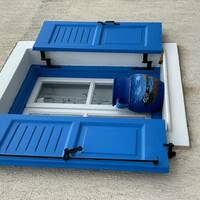 Jen
Jen This transcription item is now locked to you for editing. To release the lock either Save your changes or Cancel.
This lock will be automatically released after 60 minutes of inactivity.